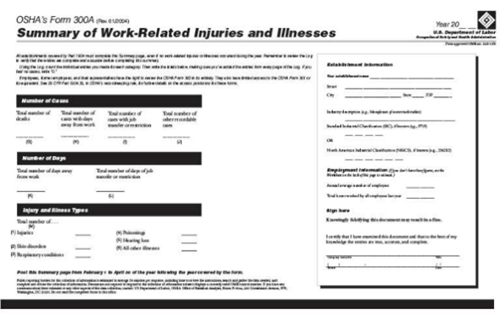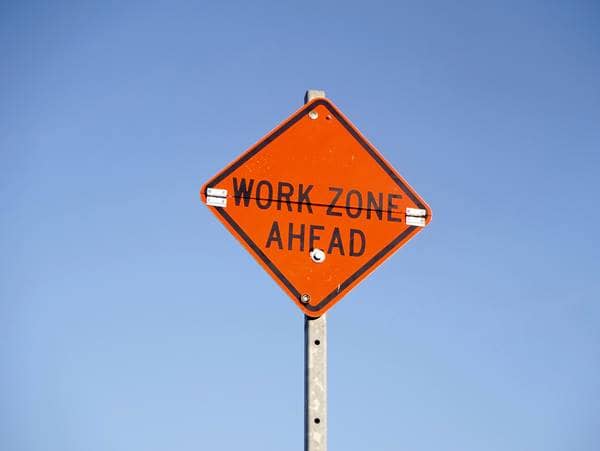Safety news

OSHA, NIOSH, and a coalition of safety organizations – including the National Safety Council – are teaming up for the sixth annual Safe + Sound Week, scheduled for August 15-21.
The national initiative is intended to help promote awareness and understanding of workplace safety and health programs. More than 5,300 employers participated in last year’s event, according to OSHA.
Registration is slated to open in July.
Source: safetyandhealthmagazine.com/articles/22397-safe-sound-week-set-for-aug-15-21?utm_source=sfmc&utm_medium=email&utm_campaign=mbrnewsalertmar25&utm_content=
OSHA initiates enforcement program to identify employers failing to submit injury, illness data

OSHA will begin identifying and citing workplaces that haven’t complied with the agency’s requirement to submit Form 300A –an annual summary of worker injury and illness data – under a newly adopted enforcement program.
Struck-by incidents are a leading cause of death among construction workers, and since 1992 the leading cause of nonfatal injuries in the construction industry. According to OSHA, the four most common struck-by hazards are being struck-by a flying, falling, swinging, or rolling object. The NORA Construction Sector Council is undertaking a number of initiatives to increase awareness of struck-by hazards and ways to prevent them, including developing this online resource and launching a National Stand-Down to Prevent Struck-by Incidents.
Downloadable resources related to work zone, lift zone, and heavy equipment safety are available online from CPWR – The Center for Construction Research and Training. They include two webinars from the last year’s National Stand-down event, along with links to more than 25 toolbox talks, infographics, data bulletins and blog posts.
Source: Occupational Safety and Health Administration (OSHA) osha.gov
Navigate work zones safely

We’ve all been there. You’re cruising down the highway when suddenly traffic slows to a crawl. There’s construction ahead, which means a lower speed limit and longer travel times. While work zones can be frustrating, precautions are necessary. In 2019, 842 people were killed and over 39,000 injured in work zone crashes. Knowing how to navigate a work zone cannot only keep road workers safe, but also ensure the safety of you and your passengers.
The Federal Motor Carrier Safety Administration provides these tips to safely maneuver work zones:
- Plan ahead: Research your route ahead of time and note where work zones are located
- Pay attention: Stay focused on the road at all times
- Read all signs: They might be telling you to change lanes or reduce speed
- Slow down: Most work zones have lower speed limits; if you see road workers, slow down further, give them extra room and always be prepared to stop
- Move into the open lane: If your lane is closed, move over as soon as you can
- Keep your distance: Rear-end crashes happen frequently in work zones; never cut off another vehicle – especially a truck or bus
Staying focused on driving is the best way to ensure you have time to react to anything unexpected. In work zones, workers may encroach in driving lanes, and construction vehicles may enter and leave sites at low speeds and in unexpected places. Rough pavement, sharp turns, large drop-offs, and old pavement markings also can pose risks. Avoid distractions and keep your eyes on the road.
Source: nsc.org/hidden-pages/member-newsletters/safety-spotlight?utm_source=sfmc&utm_medium=email&utm_campaign=MBR%20712758%20-%20Safety%20Spotlight%20Monthly&utm_content=#Workzones
10 ergonomic strategies to protect your aging workforce from Injury
Older workers still make up a large portion of the workforce, and the labor shortage is creating enticing opportunities for those who left employment to return. Effective ergonomics applies to all employees, but its importance magnifies as we age.
Workers over the age of 55 represent a large and essential segment of the American economy, and their influence is growing. According to the US Bureau of Labor Statistics, one-in-four US workers will be 55 or older by 2030.
During the pandemic, a large amount of older workers did exit the workforce, however, the SeniorLiving.org senior employment annual report illustrates that there are signs of that rebounding. In May 2020, 54% of workers 55 and older were either working remotely or unable to work because of the virus. Today, that figure has decreased to 15%, which may continue to decline with the wide availability of additional vaccine doses. In addition, the existing labor shortage has created attractive opportunities for older adults. Those who previously left or lost their jobs may re-enter the workforce with a prospect of earning higher wages and receiving better benefits.
These statistics send a clear message to employers. Proactive management of the risk factors associated with an aging workforce is essential. That means prioritizing the maximization of productivity by minimizing worker fatigue and discomfort – otherwise known as ergonomics.
“Repetitive motion and awkward postures, such as bending, stooping, overreaching, and wrist deviation, are all ergonomic risk factors,” said Ariel Jenkins, Assistant Vice President of Risk Services at Safety National. “An aging workforce cannot continue to meet production demands by subjecting itself to risk factors that exacerbate the natural degeneration of the body without experiencing severe musculoskeletal injuries at some point.”
Workers compensation interventions for an aging workforce must be viewed as an investment with the return on that investment being reduced losses. A corporate culture that fails to accommodate older workers in a proactive manner can also lead to new risks and employee relations issues.
Here are 10 ergonomic strategies to consider:
1. Contact ergonomists and/or risk control professionals for their expertise on how to control and reduce the risks of ergonomic-related claims. If you do not know where to start, your insurance carrier’s risk control consultants likely have adequate ergonomics experience. It is also probable they are well connected with ergonomists and can put you in touch with an expert.
2. Take advantage of what your workers compensation claims data is telling you. Analyze employee reports of discomfort to prioritize which specific work areas to assess for ergonomics issues and, subsequently, apply work redesign and other interventions where possible. Experts will typically apply a ‘hierarchy of controls’ approach and consider engineering, administrative, work practice, and equipment controls.
3. Set defined expectations for both footwear and body mechanics. Footwear expectations should be aligned with controlling risks of the walking, standing, or climbing work surfaces. For example, if the work surface is slippery, concrete, or some other hard surface, the workplace footwear should be slip resistant and designed for standing on concrete and other hard surfaces within the work environment. Anti-fatigue mats used in conjunction with the best workplace footwear reduces compression forces to the lower back and lower extremities (ankles and knees).
4. Establish body mechanics methods by job description to help educate employees on how to handle objects manually with minimal impact to vulnerable areas of the body.
5. Apply functional employment testing (also known as fit-for-duty testing) during the hiring process to help ensure you are acquiring employees that are physically capable of performing the job. Typically, functional employment testing is conducted after an employment offer has been made. If the sequence of conducting functional employment testing is in question, be sure to seek advice from HR and/or legal professionals.
6. Set up ergonomics steering committees with stakeholders that can help influence and drive a culture of safety. Regardless of the methods of control, ergonomic interventions must be inclusive and accepted by the workforce to be effective.
7. Establish a ‘stretch and flex’ program, which includes regular stretching and strengthening of the muscles that are commonly associated with sprains, strains, and other ergonomic injuries.
8. Consider providing on-the-job workers compensation physical rehabilitation, which helps reduce indemnity costs and tends to help injured employees recover and heal faster.
9. Encourage routine use of primary care physicians for health issues that are not related to work. When a workplace injury occurs, comorbidities can exacerbate the injury and complicate the healing process.
10. When applicable, involve ergonomists in the design of work areas. Do this as early as possible in the pre-construction planning stages.
Source: carrierchronicles.com/10-ergonomic-strategies-to-protect-your-aging-workforce-from-injury/
Tips for safe driving

Whether you’re headed just down the road or across state lines, good driving is key to interacting with other vehicles and arriving safely at your destination. Here are tips for a safer drive:
- Set up your drive: Before you drive, put your phone on “do not disturb” and place it out of sight, program your GPS and playlists, and adjust your mirrors, seat, and air temperature
- Never drink and drive; impairment begins with your first drink
- If taking medication, check the side effects before getting behind the wheel
- Always wear a seat belt, and make sure your passengers are wearing theirs
- On longer trips, schedule breaks where you can get out to stretch or check your phone
- Perform regular inspections of your vehicle before driving
- Follow the R U A Safe Driver collision prevention formula: Recognize the hazard, Understand the defense, and Act correctly in time
- Follow the 3-second plus rule: Slow down and increase your following distance even more in bad weather or when visibility is reduced
- In rural areas, look out for deer on the road
You may be tempted to send a quick text, grab a bite, or reach into the back to grab something while driving. Any of these distractions could prove deadly. Driving cannot truly be safe unless it is distraction-free. Take some time in April – Distracted Driving Awareness Month – to learn more about distraction-free driving and sign our Just Drive Pledge.
Source: National Safety Council nsc.org/hidden-pages/member-newsletters/safety-spotlight?utm_source=sfmc&utm_medium=email&utm_campaign=MBR%20712758%20-%20Safety%20Spotlight%20Monthly&utm_content=#Workzones
Safety technology in the workplace: NSC, DEKRA release white paper
Because “having safety technology accessible to companies of all sizes is critical to reducing and eliminating workplace fatalities,” the National Safety Council, through its Work to Zero initiative, has partnered with DEKRA on a white paper that provides a roadmap to assist employers on their safety journey.
Safety Technology Pilot and Implementation Roadmap: Making Innovation Accessible also identifies challenges to innovation.
“The National Safety Council is doubling down on efforts like the Work to Zero initiative to help companies keep their workers safe by understanding the technology to enable them do so,” said Paul Vincent, Executive Vice President of the Workplace Practice at NSC. “Fatalities should never be the cost of doing business, and this report delivers a clear path for employers to embrace safety technologies, which will save lives.”
Each year, nearly 5,000 workers are lost to preventable causes. Work to Zero aims to reverse this trend through the promise of technology, with the ultimate goal of eliminating workplace fatalities by 2050.
According to Dr. Mei-Li Lin, Senior Vice President for Innovation, Solution, and Partnership at DEKRA, “Organizations that invest in developing an innovative spirit, as well as learn to be agile and resilient, can reap the optimal benefit of what technology has to offer.”
Funded by the McElhattan Foundation, Work to Zero is making innovation more accessible by helping employers explore the value of safety technology and how to determine their organization’s readiness for adopting new technology solutions.
Prevent falls when working near rooftop hatches
Guarding floor, wall openings, and holes is a requirement under OSHA’s fall protection standard. Hatches, which provide workers with direct access to a rooftop where equipment is often stored, fall under this requirement.
Help prevent falls when working near hatches. According to CPWR – The Center for Construction Research and Training, you should take several steps before work begins:
- Use a fixed ladder to access the roof, and use a secure extension ladder to restrict movement if you don’t have a fixed ladder
- Install grab bars to use when transitioning from the ladder to the roof
- Install guardrails around the open sides of the hatch
Install a swing gate that opens away from the hatch opening
Once work begins, workers should:
- Make sure their path to and through the hatch is free of debris
- Be in communication with other workers
- Use the grab bars when accessing the hatch
- Close the hatch lid when not in use
- Not use the hatch lid as a place to sit
- Wear appropriate personal protective equipment when working at a height of six feet or higher
Source: safetyandhealthmagazine.com/articles/21722-prevent-falls-when-working-near-rooftop-hatches

This "document” is intended for general information purposes and should not be construed as advice or opinions on any specific facts or circumstances. The content of this document is made available on an “as is” basis, without warranty of any kind. This document cannot be assumed to contain every acceptable safety and compliance procedure or that additional procedures might not be appropriate under the circumstances. Markel does not guarantee that this information is or can be relied on for compliance with any law or regulation, assurance against preventable losses, or freedom from legal liability. This publication is not intended to be legal, underwriting, or any other type of professional or technical advice. Persons requiring advice should consult an independent adviser or trained professional. Markel does not guarantee any particular outcome and makes no commitment to update any information herein, or remove any items that are no longer accurate or complete. Furthermore, Markel does not assume any liability to any person or organization for loss or damage caused by or resulting from any reliance placed on this content.
Markel® is a registered trademark of Markel Group Inc.
© 2023 Markel Service, Incorporated. All rights reserved.
